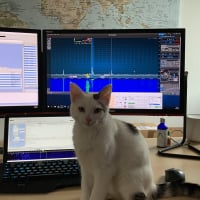SmartSDR v4.1.3 | SmartSDR v4.1.3 Release Notes
SmartSDR v3.10.15 | SmartSDR v3.10.15 Release Notes
The latest 4O3A Genius Product Software and Firmware
Need technical support from FlexRadio? It's as simple as Creating a HelpDesk ticket.
Pretty awesome AI driven noise cancelling Software - RM Noise
Comments
-
https://www.youtube.com/playlist?list=PL9Qk9cH1XFDsKe6TbZhLkCRHB6nVpO65R
0 -
I have found that it tends to cover up weak signals near the noise floor just like the noise reduction in SmartSDR will do if used in an effort to remove the background noise. The only noise reduction I have found that works well with weak signals is Noise Reduction 2 from Dr Warren Pratt that is used in Thetis, PiHPSDR and a few other, open source software. This is the reason I stopped using RM Noise plus, as more users logged into the server(s) latency tended to increase to a noticeable and annoying level. On top of that, I do not like the idea of having to use a off site server to process the audio. I like standalone operation ( the reason I prefer the Flex M model radios) whenever I don't want to fire up a computer to play radio.
James
WD5GWY
0 -
I found that on a weak signal with RM Noise dropping AGC-T seemed to bring the weaker signal up better
0 -
I have tried every combination of settings including lowering AGC-T while using RM Noise. That does work to a degree just as it does with the noise reduction in SmartSDR. But, at some point it seems to invariably knock out the weak signal. RM Noise would be a good tool if it didn't depend on a off site server for audio processing. To me, that is a no-go, I don't want to be dependent on a system like that for noise reduction. I would be willing to pay for a standalone application to run on my computer without a internet connection. Everyone's different. If one is satisfied with the limitations of RM Noise, then it is a good deal.
James
WD5GWY
1 -
trucker
Agree
I’d rather it was in radio as best option, 2nd best option stand alone software on pc. But its free at the moment so it is what it is.
1
Leave a Comment
Categories
- All Categories
- 377 Community Topics
- 2.1K New Ideas
- 630 The Flea Market
- 8.2K Software
- 110 SmartSDR+
- 6.4K SmartSDR for Windows
- 183 SmartSDR for Maestro and M models
- 428 SmartSDR for Mac
- 271 SmartSDR for iOS
- 257 SmartSDR CAT
- 190 DAX
- 382 SmartSDR API
- 9.3K Radios and Accessories
- 36 Aurora
- 252 FLEX-8000 Signature Series
- 7.2K FLEX-6000 Signature Series
- 943 Maestro
- 55 FlexControl
- 865 FLEX Series (Legacy) Radios
- 919 Genius Products
- 461 Power Genius XL Amplifier
- 335 Tuner Genius XL
- 123 Antenna Genius
- 296 Shack Infrastructure
- 208 Networking
- 454 Remote Operation (SmartLink)
- 144 Contesting
- 786 Peripherals & Station Integration
- 139 Amateur Radio Interests
- 1K Third-Party Software

